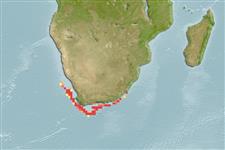Common names from other countries
Elasmobranchii (hajar och rockor) (sharks and rays) >
Rajiformes (Skates and rays) >
Rajidae (Skates)
Etymology: Neoraja: Greek, neos = new + Latin, raja = fish, Raja sp. (Ref. 45335).
Environment: milieu / climate zone / depth range / distribution range
Ekologi
marina djupbottenlevande; djupintervall 102 - 1025 m (Ref. 5578). Deep-water; 29°S - 40°S
Southeast Atlantic: off the Orange River mouth to south of the Agulhas Bank, South Africa.
Size / Vikt / Age
Maturity: Lm ? range ? - ? cm
Max length : 37.6 cm TL hane/ej könsbestämd; (Ref. 106604)
Short description
Bestämningsnycklar | Morfologi | Morfometri
A dwarf softnose skate with a bluntly pointed snout and very large close-set eyes; tail longer than body in adult; pectoral disc angular with rounded corners, and anterior edges more undulated in adult male than in female; large thorns around eyes, on shoulders, and in interrupted single row from back to dorsal fins (Ref. 5578). Brownish-grey above, with 6-7 crossbars on tail; underside pale with dark brown areas along the front and rear edges of disc, on snout and on underside of tail (Ref. 5578).
Found on the upper slope (Ref. 5578). Oviparous (Ref. 50449). Eggs have horn-like projections on the shell (Ref. 205). Probably taken by hake trawlers (Ref. 5578).
Life cycle and mating behavior
Maturities | Reproduktion | Spawnings | Egg(s) | Fecundities | Larver
Oviparous, paired eggs are laid. Embryos feed solely on yolk (Ref. 50449).
McEachran, J.D. and K.A. Dunn, 1998. Phylogenetic analysis of skates, a morphologically conservative clade of elasmobranchs (Chondrichthyes: Rajidae). Copeia 1998(2):271-290. (Ref. 27314)
IUCN Red List Status (Ref. 130435)
CITES (Ref. 128078)
Not Evaluated
Threat to humans
Harmless
Human uses
Verktyg
Special reports
Download XML
Internet-källor
Estimates based on models
Preferred temperature (Ref.
115969): 6.1 - 12.1, mean 10.8 (based on 9 cells).
Phylogenetic diversity index (Ref.
82804): PD
50 = 0.5312 [Uniqueness, from 0.5 = low to 2.0 = high].
Bayesian length-weight: a=0.00646 (0.00364 - 0.01145), b=3.29 (3.14 - 3.44), in cm Total Length, based on LWR estimates for this species & (Sub)family-body (Ref.
93245).
Trofisk nivå (Ref.
69278): 3.7 ±0.6 se; based on size and trophs of closest relatives
Resiliens (Ref.
120179): Låg, lägsta populationsfördubblingstid 4,5-14 år (Fec assumed to be <100).
Fishing Vulnerability (Ref.
59153): Low to moderate vulnerability (28 of 100).
